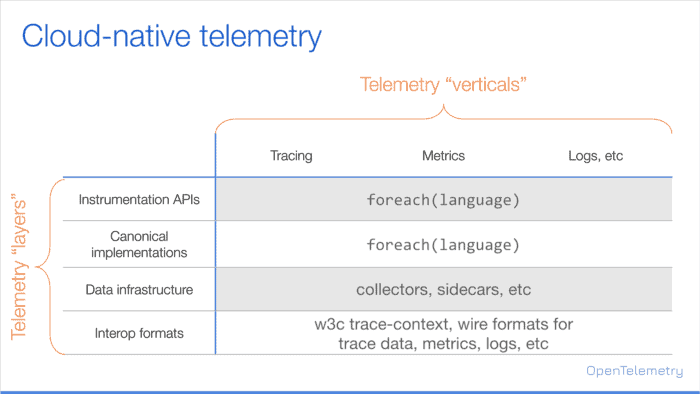by Ben Sigelman, co-creator of OpenTracing and member of the OpenTelemetry governing committee, and Morgan McLean, Product Manager for OpenCensus at Google since the project’s inception
After many months of planning, discussion, prototyping, more discussion, and more planning, OpenTracing and OpenCensus are merging to form OpenTelemetry, which is now a CNCF sandbox project. The seed governance and technical committees are composed of representatives from Google, LightStep, Microsoft, and Uber, and more organizations are getting involved every day.
We couldn’t be happier about it – here’s why.
Observability, Outputs, and High-Quality Telemetry
Observability is a fashionable word with some admirably nerdy and academic origins. In control theory, “observability” measures how well we can understand the internals of a given system using only its external outputs. If you’ve ever deployed or operated a modern, microservice-based software application, you have no doubt struggled to understand its performance and behavior, and that’s because those “outputs” are usually meager at best. We can’t understand a complex system if it’s a black box. And the only way to light up those black boxes is with high-quality telemetry: distributed traces, metrics, logs, and more.
So how can we get our hands – and our tools – on precise, low-overhead telemetry from the entirety of a modern software stack? One way would be to carefully instrument every microservice, piece by piece, and layer by layer. This would literally work, it’s also a complete non-starter – we’d spend as much time on the measurement as we would on the software itself! We need telemetry as a built-in feature of our services.
The OpenTelemetry project is designed to make this vision a reality for our industry, but before we describe it in more detail, we should first cover the history and context around OpenTracing and OpenCensus.
OpenTracing and OpenCensus

In practice, there are several flavors (or “verticals” in the diagram) of telemetry data, and then several integration points (or “layers” in the diagram) available for each. Broadly, the cloud-native telemetry landscape is dominated by distributed traces, timeseries metrics, and logs; and end-users typically integrate with a thin instrumentation API or via straightforward structured data formats that describe those traces, metrics, or logs.
For several years now, there has been a well-recognized need for industry-wide collaboration in order to amortize the shared cost of software instrumentation. OpenTracing and OpenCensus have led the way in that effort, and while each project made different architectural choices, the biggest problem with either project has been the fact that there were two of them. And, further, that the two projects weren’t working together and striving for mutual compatibility.
Having two similar-yet-not-identical projects out in the world created confusion and uncertainty for developers, and that made it harder for both efforts to realize their shared mission: built-in, high-quality telemetry for all.
Getting to one project
If there’s a single thing to understand about OpenTelemetry, it’s that the leadership from OpenTracing and OpenCensus are co-committed to migrating their respective communities to this single and unified initiative. Although all of us have numerous ideas about how we could boil the ocean and start from scratch, we are resisting those impulses and focusing instead on preparing our communities for a successful transition; our priorities for the merger are clear:
- Straightforward backwards compatibility with both OpenTracing and OpenCensus (via software bridges)
- Minimizing the time where OpenTelemetry, OpenTracing, and OpenCensus are being co-developed: we plan to put OpenTracing and OpenCensus into “readonly mode” before the end of 2019.
- And, again, to simplify and standardize the telemetry solutions available to developers.
In many ways, it’s most accurate to think of OpenTelemetry as the next major version of both OpenTracing and OpenCensus. Like any version upgrade, we will try to make it easy for both new and existing end-users, but we recognize that the main benefit to the ecosystem is the consolidation itself – not some specific and shiny new feature – and we are prioritizing our own efforts accordingly.
How you can help
OpenTelemetry’s timeline is an aggressive one. While we have many open-source and vendor-licensed observability solutions providing guidance, we will always want as many end-users involved as possible. The single most valuable thing any end-user can do is also one of the easiest: check out the actual work we’re doing and provide feedback. Via GitHub, Gitter, email, or whatever feels easiest.
Of course we also welcome code contributions to OpenTelemetry itself, code contributions that add OpenTelemetry support to existing software projects, documentation, blog posts, and the rest of it. If you’re interested, you can sign up to join the integration effort by filling in this form.